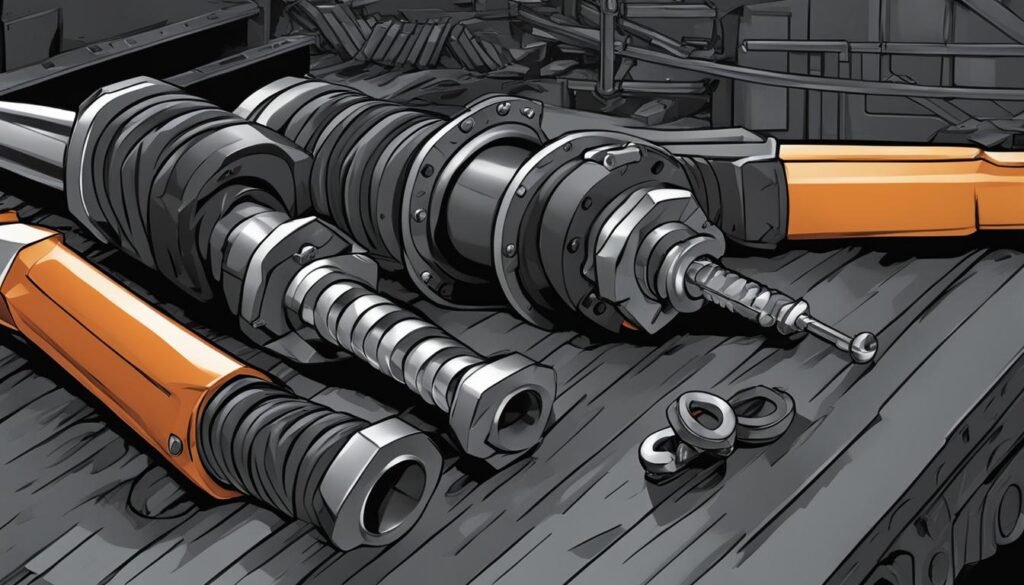A turnbuckle is a versatile rigging device that is used to adjust tension and eliminate slack in various tensioning systems. It consists of three main components: a body, a right-hand threaded end fitting, and a left-hand threaded end fitting. Turnbuckles are commonly used in industries such as construction, maritime transport, aviation, sports and entertainment, and more. They can be used for applications ranging from simple fencing to complex suspension bridge construction. Turnbuckles come in different types, sizes, and materials, including galvanized steel and stainless steel. The choice of material depends on factors such as corrosion resistance and durability. Proper installation and sizing of turnbuckles are vital to ensure their safe and effective use in different applications.
Key Takeaways:
- A turnbuckle is a rigging device used for adjusting tension and eliminating slack in various systems.
- It consists of a body and two threaded end fittings.
- Turnbuckles are widely used in construction, maritime transport, aviation, and sports and entertainment industries.
- They come in different types, sizes, and materials, such as galvanized steel and stainless steel.
- Proper installation and sizing of turnbuckles are crucial for their safe and effective use.
How Do Turnbuckles Work: Understanding the Mechanics of Tension Adjustment
A turnbuckle is a versatile rigging device that enables the adjustment of tension in various tensioning systems. But how exactly do turnbuckles work? Let’s delve into the mechanics of tension adjustment and unravel the mystery behind these ingenious devices.
Turnbuckles operate using opposite-direction threads on the body and end fittings. When the body is rotated in one direction, the end fittings are pushed out of the body, extending to relieve tension. Conversely, rotating the body in the opposite direction causes the end fittings to retract toward the center, increasing tension. This unique design allows for precise increments of tension adjustment without the need for additional tools.
The amount of tension applied depends on the distance between the end fittings and the type of material used in the turnbuckle. This adjustability makes turnbuckles suitable for a wide range of applications, from simple fencing to complex construction projects like suspension bridge building. Whether you’re tightening cables on a ship’s rigging or securing a wrestling ring, turnbuckles provide reliable and efficient tension adjustment.
The Importance and Applications of Turnbuckles in Various Industries

With their extensive product selection, expert guidance, and commitment to quality, Marsh Fasteners is your go-to supplier for top-quality turnbuckles. Whether you need turnbuckles for construction, maritime transport, aviation, or any other industry, Marsh Fasteners has you covered. Contact them today to discuss your specific requirements and experience the reliability and performance of their turnbuckles.
Understanding the Different Types and Components of Turnbuckles
Turnbuckles are available in various types and configurations, each designed for specific purposes. Whether you need a jaw and jaw, eye and jaw, eye and eye, hook and hook, or hook and eye turnbuckle, the choice of end fittings depends on your application requirements.
The main components of a turnbuckle include the body, which acts as the central frame connecting the end fittings. The nut or jam nut plays a crucial role in preventing the turnbuckle from loosening during use. The end fittings themselves can be hooks, jaws, or eyes, and their selection depends on factors such as the need for temporary or permanent connections, the ability to open or close the fittings, and the level of tension adjustment required.
It is imperative to choose the right type of turnbuckle and ensure proper matching of its components with other rigging components. This is crucial to ensure the safe and effective use of turnbuckles in your specific applications. Remember, the right combination of turnbuckle type and components will provide the necessary tension adjustment and support for your project.
FAQ
What is a turnbuckle?
A turnbuckle is a versatile rigging device used to adjust tension and eliminate slack in various tensioning systems.
How do turnbuckles work?
Turnbuckles work by utilizing opposite direction threads on the body and end fittings to adjust tension in a tensioning assembly. By rotating the body, the end fittings extend or retract to increase or relieve tension.
What industries use turnbuckles?
Turnbuckles are commonly used in industries such as construction, maritime transport, aviation, sports and entertainment, and more.
What are the applications of turnbuckles?
Turnbuckles can be used for applications ranging from simple fencing to complex suspension bridge construction, as well as tension support in large buildings, highway guardrails, ship lashing, aircraft structures, wrestling and boxing rings, carpentry, plumbing, electrical installations, playground equipment, and cable railing systems.
How should turnbuckles be installed and maintained?
During installation, turnbuckles should be fully extended, connected to securement points, and rotated to tighten the rope or cable. Periodic inspection for damage, corrosion, or wear is necessary, and turnbuckles should be removed from service if any issues are present.
How do I select the right turnbuckle?
Factors to consider include the type and size of end fittings, the material of the turnbuckle (galvanized steel or stainless steel), and the required working load limit (WLL) for your application. Marsh Fasteners is a reputable supplier that offers a wide range of turnbuckles and expert guidance.
What are the different types and components of turnbuckles?
Common types include jaw and jaw, eye and jaw, eye and eye, hook and hook, and hook and eye turnbuckles. Components consist of the body, nut or jam nut, and end fittings such as hooks, jaws, or eyes.

